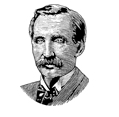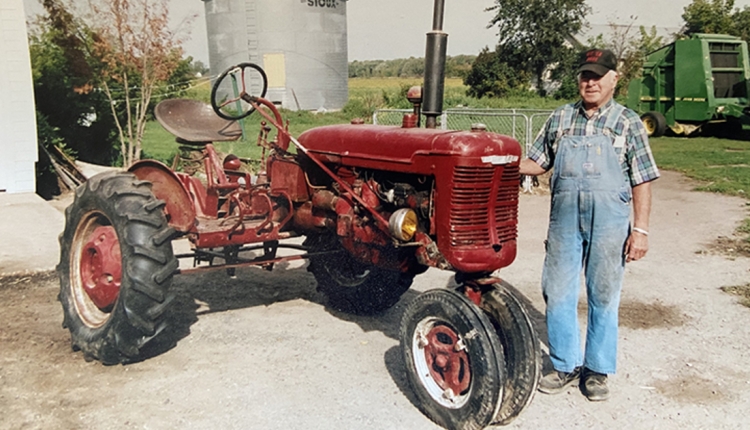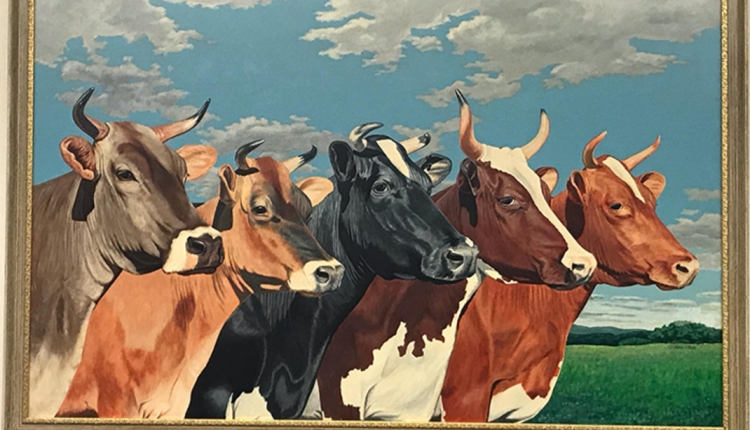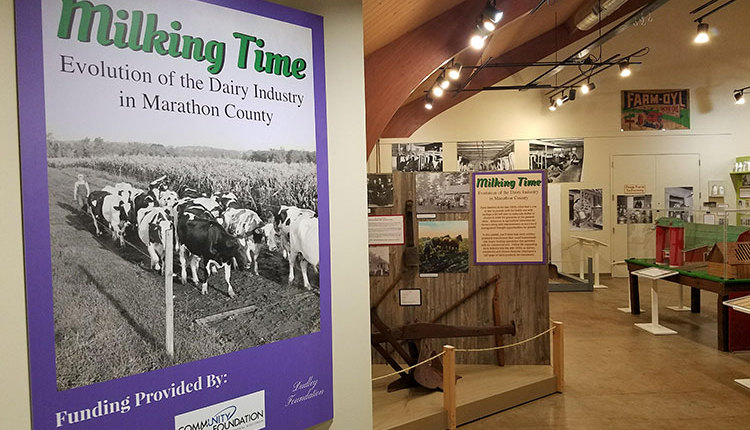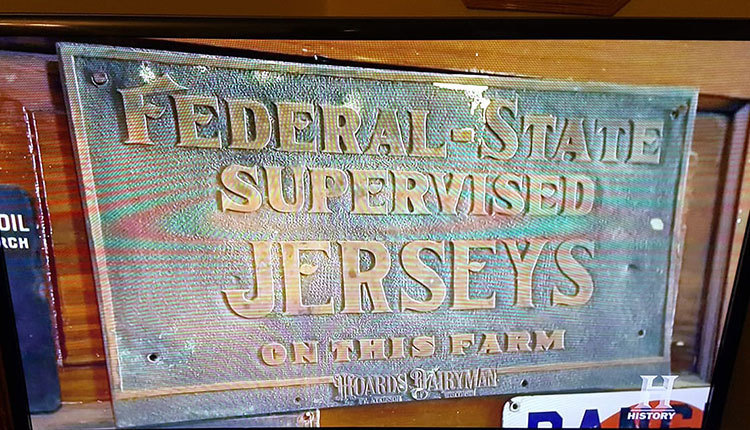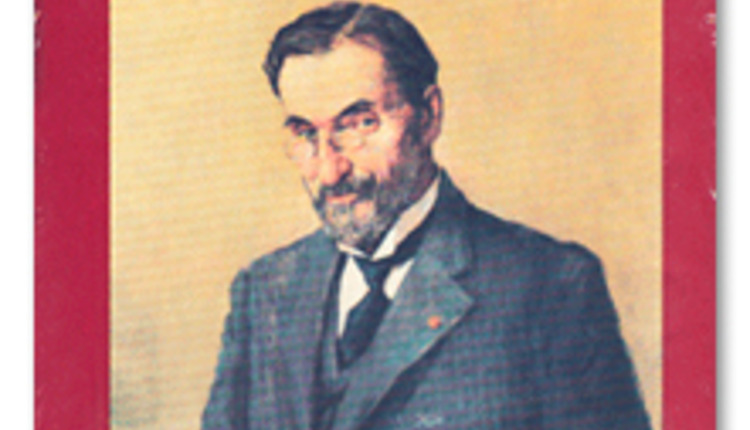
1871
- To combat the depletion and erosion of soil resources brought about by a one-crop system of agriculture, W. D. Hoard founded the first dairymen's association in Jefferson County, Wisconsin. One year later, he led the "seven wise men" in founding the Wisconsin Dairymen's Association. Through it the dairy industry became the backbone of a permanent, soil-building and conserving type of agriculture.
- W. D. Hoard secured a reduction in freight rates and obtained the first refrigerator car ever to ship Wisconsin cheese to eastern markets.
- Hoard's Dairyman, "a journal devoted to dairy farming," is founded and published as a supplement to the 15-year-old weekly, The Jefferson County Union.
- W. D. Hoard elected the 16th Governor of Wisconsin.
- Made and financed the first Cow Census ever undertaken in the United States. It was forerunner of dairy herd improvement associations that now include 4,500,000 cows all over the nation.
- Dairying achieves academic recognition with the establishment of the first dairy school in America at the University of Wisconsin. Hoard is governor.
- Hoard's Dairyman publishes first article on alfalfa. Began intensive promotion. The crop is now the greatest forage producing plant in the United States. And Hoard is now credited as "the father of alfalfa culture."
- Grass or hay silage first recommended as a means of preserving the hay crop from weather damage. Practice now widely followed.
- Began promotion of tuberculosis eradication, a bitter campaign to last 45 years, with Hoard's Dairyman leading the fight. Struggle to cost thousands of cancelled subscriptions and lost revenue as magazine battles almost alone in early years to free herds from heavy health losses and protect the consuming public from milk-borne tuberculosis.
- W.D. Hoard purchased a 193-acre dairy farm just north of Fort Atkinson. Provided a place where Hoard's Dairyman editors could "keep their feet on the ground.
- Associate editor A. J. Glover serves as general manager of the first National Dairy Show held in Chicago, Ill. Holds post until 1913.
- After being appointed to the University of Wisconsin Board of Regents, Hoard is selected to serve as Regent president from 1908 to 1911.
- At W. D. Hoard's prodding, University of Wisconsin is first great university to formally recognize farmers in public tribute. Honored were men who had "stimulated progress, dispelled ignorance and added greatly to the uplift of the farming class."
- Construction begins on Hoard's Dairyman national office. Publishing team moves into the office in 1910.
- First discussed loose or pen housing for dairy cattle. Laborsaving advantages and low initial investment stressed through the years. Later accepted nationwide.
- W. D. Hoard's portrait hung in famed Saddle and Sirloin Club in recognition of his great contribution to American agriculture
- "Wisconsin's most distinguished citizen" named at World's Fair in San Francisco is W. D. Hoard.
- Began first youth page for boys and girls on dairy farms. Over 75,000 youngsters enrolled in Hoard's Dairyman Juniors. Encouraged young people to stay on dairy farms with their parents. Taught fundamentals. Forerunner of internationally known 4-H and FFA rural youth organizations.
- Discovery of vitamins first reported in Hoard's Dairyman by Dr. E. V. McCollum.
- Hoard's Dairyman was the dominating influence in the founding of the herd test, proved sire, brood cow research program conducted by the U.S. Department of Agriculture.
- After 22 years of Hoard's Dairyman campaigning for tuberculosis eradication, federal government finally launches program. Led to "cattle testing wars." Farmers fought condemnation of tubercular cattle, bootlegged them into untested areas. Editors courageously addressed mobs of angry farmers throughout country.
- Arthur J. Glover succeeds deceased founder as editor. Glover pioneered herd production testing, first in U.S., in Illinois in 1902. Joined editorial staff in 1904.
- Grassland farming philosophy initiated, with "More milk per acre" articles. They became school and university texts, exerted profound influence on dairy industry. Pastures were classified as a high income crop rather than exercise lots and wasteland.
- Hoard's Dairyman campaigned successfully for the elevation of the U.S. Dairy Division to the status of a Bureau in the Department of Agriculture.
- A. J. Glover recognized at State Dinner by President Hoover as the man who had made the greatest contribution to American agriculture during the decade.
- Cow Judging Contest launched in picture form in Hoard's Dairyman. Over 5.5 million entries have been received since it began. Brought art of breeding better dairy cattle into the classrooms of the nation.
- A. J. Glover elected to serve a four-year term as president of the Holstein-Friesian Association of America now known as Holstein USA.
- University of Wisconsin Board of Regents elects A. J. Glover as president; a role he holds until 1943.
- Entire nation declared free from tuberculosis in cattle. Medical leaders hail campaign as "man's greatest victory over tuberculosis." Successful culmination of campaign started by W. D. Hoard 45 years earlier.
- E.C. Meyer, J.S. Baird, and W.D. Knox begin careers with Hoard's in the 1940s. Together they have 142 years of service to the magazine.
- Hoard's Dairyman supports renewed campaign against brucellosis, most serious livestock menace. Livestock industry confused, torn by dissension. Incidence doubled since 1941. Disease causes undulant fever in humans.
- First national magazine column on artificial breeding of dairy cattle. Greatest single development in dairying since origin of herd test in 1902. Today, there are over 9 million cows bred by artificial insemination with the nation's best germ plasm.
- William David Knox succeeds deceased second editor, A. J. Glover.
- Uniform national program approved for brucellosis control. Hoard's Dairyman editor, W. D. Knox, elected to lead medical, farm and dairy industry forces to eradication goal through National Brucellosis Committee.
- Tense and divided Wisconsin livestock industry asks Hoard's Dairyman editor, W. D. Knox, to lead effort to develop effective disease control program. Five years later, state is free of brucellosis and Wisconsin is accepted model for all states.
- As postwar milk production begins to outstrip demand and dairy prices falter, Hoard's Dairyman editorial, "Hour of decision-sell or suffer," starts nationwide voluntary contributions for advertising dairy products, research and market development.
- Famed Ed and Emma cartoon series debuts in Hoard's Dairyman. Drawn by Chuck Stiles, Ed and Emma is the longest continuous cartoon series drawn by one person.
- Five cows, all sired by Playhaven's Y Plymouth, classify Excellent at the Hoard's Dairyman Farm.
- Postwar buildup of farm surpluses reaches critical stage. Hoard's Dairyman advances self-help dairy program designed to rid government of heavy costs and surpluses, and place program in hands of farmers for self-financed market stabilization. Program supported by four national farm and dairy organizations.
- Hoard's Dairyman Continuing Market Study is launched. Annual survey of 3,000 readers gives most in-depth look into dairy industry.
- New yardstick of dairy efficiency advanced by Hoard's Dairyman to guide nation's dairy farmers. More-milk-per-man concept is first benchmark to adequately relate labor efficiency to dairy profit.
- The original Foster Mothers portrait was painted by Hoard's Dairyman Art Director Jim Baird.
- National Mastitis Council launched. Hoard's Dairyman asked to keynote formation meeting. First industry-wide effort to reduce dairying's most costly disease of dairy cattle.
- W. D. Knox elected president of National Dairy Shrine.
- W. D. Knox named by President of United States to bipartisan National Agricultural Advisory Commission to advise White House on farm policy. Only editor in U. S. ever appointed.
- Class I Base Bill passes Congress. Initiated by Hoard's Dairyman. First amendment in 28 years to federal milk order legislation. Passage followed four years of struggle.
- Dairy Shrine names W. D. Knox Guest of Honor for his national leadership in the field of dairy cattle health, expanding the markets for dairy products and development of peacetime dairy programs to improve the economic lot of the American dairy farmer.
- Hoard’s Dairyman Farm donates Lot 25 for historic April 1967 sale. That event gives rise to World Dairy Expo. In all, 82 breeders participate.
- Published first ranking of A.I. sires on Predicted Difference for milk. Meant great leap forward in use of genetically superior sires, resulting in higher producing herds, more efficient industry.
- Urged merger of National Dairy Council and American Dairy Association in an effort to bring harmony and coordination in dairy research, education and promotion. Resulted in creation of United Dairy Industry Association in 1970.
- W. D. Knox named World Dairy Expo 1970 Industry Person of the Year.
- W. D. Knox receives Distinguished Service Award, American Dairy Science Association.
- Launched campaign proposing that milk be priced on protein content as a means of more equitable pricing. Would lead to even better quality beverage milk.
- Eugene C. Meyer succeeds William D. Knox as managing editor. Knox named editor and general manager.
- Honorary Doctor of Laws degree awarded by University of Wisconsin to W. D. Knox "for his contributions to the welfare of one of Wisconsin's great industries, as a constructive and influential leader in an important segment of professional journalism, and as the architect of significant national agricultural policies."
- Gave strong editorial support to Grade Identification plan for nonregistered Holsteins, later adopted by National Holstein Association.
- Editors urged readers to use calf hutches to cut losses due to inadequate ventilation and sanitation. Put into use at Hoard's Dairyman Farm. Now used to raise calves on one out of every three farms in the U. S.
- Editors designed and demonstrated at Hoard's Dairyman Farm new heifer housing concept. Open air, natural ventilation style which was consistent with calf-hutch environment.
- President of United States names W. D. Knox to Advisory Committee on Trade Negotiations. Sole representative of dairy industry. Only editor in U.S. appointed. Advised President and Congress on General Agreement on Tariffs and Trade, involving 98 nations, over 7,000 products and $1 trillion in trade. Saved U.S. dairy industry from ruinous dumping of foreign surplus on U.S. market. Editor served under Presidents Ford, Carter and Reagan.
- New Zealand government asks W. D. Knox to be its guest in study of N.Z. dairy industry. Reported on N.Z. and Australian role in world trade in dairy products, impact on U.S. dairymen.
- U.S. Secretary of the Interior names Hoard's Dairyman Farm to "National Register of Historic Places."
- For the first time, published "Real Rate" of set aside for dairy product promotion for the entire country. Resulted in major increases by many states and regions.
- Led campaign against effort by Community Nutrition Institute (CNI) to reclassify reconstituted milk under federal milk marketing orders.
- Managing editor, E. C. Meyer, receives Distinguished Service Award, American Dairy Science Association.
- Dairy Shrine dedicated in Fort Atkinson, Wisconsin, home of Hoard's Dairyman. National dairy leaders selected site for long-desired museum and historical exhibit. Managing editor, E. C. Meyer, led final drives for funds, making Shrine a reality.
- Cheese yield pricing plan advanced as an incentive to produce milk with high protein content rather than discouraging high solids, as do most payment plans.
- Published first interview with Cornell's Dale Bauman, whose research on bovine growth hormone revealed a 10 to 40 percent boost in production when administered to cows fresh 60 to 100 days.
- Veterinary editor, Dr. Lee A. Allenstein, honored as the U.S. Bovine Practitioner of the Year.
- Hoard's Dairyman survey shows strong support for Dairy Surplus Reduction Act of 1983.
- Johne's disease recognized as a problem in 26 states by Hoard's Dairyman survey. Farm enrolled in pioneering control program
- Hoard's Dairyman gives strong support to proposal for dairy promotion order that would provide a 15-cent-per-hundred checkoff for dairy promotion and research.
- Taxpayers will be saved $1.3 billion in dairy program costs as 37,888 dairymen sign contracts to cut milk output 7.5 billion pounds in 1984 - 9.4 billion during the 15-month diversion program.
- January 25 editorial page looks back on 100 years of serving dairy farmers. On January 23, 1885, a weekly journal was launched, the first publication devoted solely to dairymen. A section in each of four 1985 issues was devoted to 25 years of Hoard's Dairyman.
- Herd buyout is major feature of new dairy legislation, with strong editorial support. Despite strong lobbying for cut in dairy support price by the Administration, it stays at $11.60 for all of 1986.
- Published the first ranking of dairy cooperatives. Annual list sheds light on cooperative's share of national milk marketing.
- E. H. Row, named president of prestigious National Mastitis Council.
- E. C. Meyer, named National Dairy Shrine Guest of Honor in recognition of editorial leadership and high regard in the industry as a counselor for a wide range of dairy organizations.
- With more and more news stories relating fat to heart disease and cancer, Hoard's Dairyman warns it's time to "bite the bullet" on fat. Until the industry changes its pricing structure, the fat issue will be with us.
- Following years of urging through editorials, USDA included protein pricing in a recommended merger of the Great Basin and Lake Mead federal milk marketing order.
- Hoard's Dairyman calls for merging of two national dairy promotion groups - UDIA and National Dairy Board - to end duplication that exists.
- After years of campaigning for increased funding, dairy farmers no longer are "light spenders" on advertising and promotion - rank 65th among nation's largest advertisers, contributing $210 million to more than 80 U.S. dairy promotion organizations.
- Multiple component pricing now a reality in the Great Basin federal order, beginning April 1, 1988.
- Strong editorial support to National Commission on Dairy Policy report, which recommends standby production control authority when CCC purchases of dairy products are projected to be excessive. Reported that quotas cured European milk surplus.
- E. C. Meyer, named World Dairy Expo 1988 Industry Person of the Year.
- E. H. Row succeeds E. C. Meyer as managing editor, member of the editorial staff 41 years. Meyer receives Richard E. Lyng Award for his contributions to and support of the dairy industry.
- Editorial points out that while dairy product sales have increased by more than 34 pounds per capita since 1984, funds for such product research fall far short of industry needs.
- Editors campaign against state or federal bans of controversial bovine somatotropin, pending approval by Food and Drug Administration. Unpopular position angers many readers, and some of them cancel their subscription.
- Hoard's Dairyman launches Japanese edition.
- Editorial calls for labeling A.I. sires by type of progeny test. Leads to new coding system adopted by National Association of Animal Breeders.
- Steve Larson selected as regular national commentator on syndicated DairyLine radio network.
- Steve Larson named to Western Dairy Management Conference Planning Committee.
1991
- W. D. Knox is requested to lead off testimony on national dairy policy in U.S. Senate hearings.
- Ewing Row elected a director of American Forage and Grasslands Council.
1992
- W. D. Knox named Wisconsin Agri-Business Council Man of the Year.
- Encouraged and supported reporting of commercial dairy farms those holding licenses to sell milk. USDA takes over reports in 2005.
- Named charter supporter of the Holstein Foundation.
- S.A. Lasrson elected vice-president of Dairy Shrine.
- Steve Larson elected president of Dairy Shrine.
- Hoard's Dairyman en Español is launched. Abelardo Martinez D.V.M. named first editor.
- University of Wisconsin researchers discover the protocol for Ovsynch which allowed for precise timing ovulation and enabled fixed-time insemination of lactating dairy cattle. Hoard's Dairyman was first to report it.
- Corey Geiger joins editorial staff as an associate editor, named managing editor in 2013.
- Promoted the collection and reporting of actual producer take-home pay for a number of years. In 1995, USDA began reporting mailbox prices.
- Magazine launches website www.hoards.com. Provides readers latest market information and breaking news.
- W. D. Knox named to inaugural group of American Dairy Science Association Fellows.
- S. A. Larson succeeds E. H. Row as managing editor and serves in the role from 1998 to 2012. Row serves readers of Hoard's Dairyman for 31 years
- Hoard's Dairyman launches Hoard's West, a publication specifically written for Western readers. Dennis J. Halladay named first editor of Hoard's West.
- Assistant managing editor named to Holstein Foundation's Young Dairy Leaders Institute Advisory Committee.
- Editorials lead to national review and revision of dairy export-import policy.
- Steve Larson appointed to stakeholders task force for U.S. Dairy Forage Research Center.
- Managing editor Corey Geiger becomes assistant superintendent of National 4-H Dairy Cattle Judging Contest.
- Steve Larson asked to make presentation on dairy industry research needs by USDA's Agriculture Research Service
- Steve Larson asked to serve on planning committee of National Dairy Leaders Conference.
- Managing editor Corey Geiger becomes secretary of the prestigious Klussendorf Memorial Association.
- Long-term editorial campaign on dairy breed joint efforts results in substantive talks.
- Steve Larson appointed to represent National Dairy Shrine on board of Fort Atkinson Historical Society.
- Editorials and articles on show-ring ethics bring issue into limelight . . . results in stepped-up enforcement and youth education efforts.
- Steve Larson asked to serve on board of Dairy Council of Wisconsin.
- Magazine throws support behind Cooperatives Working Together . . . an industry-wide, self-help program to improve dairy farm incomes.
- Magazine commits to improving milk quality by sponsoring the annual National Dairy Quality Award recognition program.
- W.D. Hoard & Sons Company recommits itself to dairying by expanding Hoard's Dairyman Farm herd to more than 130 cows.
- Steve Larson receives Honorary Recognition, College of Agriculture and Life Sciences, University of Wisconsin-Madison.
- Steve Larson named Kansas State University Distinguished Alumni.
- Steve Larson receives Distinguished Service Award, American Dairy Science Association.
- Cowside Practice veterinary editor, Dr. David A. Rhoda, honored as the U.S. Bovine Practitioner of the Year.
- Magazine receives Outstanding Cooperation Award from National Association of Agricultural Educators.
- Magazine extends reach by putting archives online as part of searchable database.
- Steve Larson asked to co-chair Holstein Association USA Breed of the Future committee.
- Magazine recognized by Holstein Association USA for continued support of National Dairy Bowl competition.
- Retired managing editor, E.C. Meyer, and editor, W. D. Knox, pass away within three months of each other. Together they served Hoard's Dairyman and its readers for 121 years combined.
- Managing editor named to Board of Visitors, University of Wisconsin-Madison College of Agriculture and Life Sciences.
- Steve Larson named to Board of Visitors, University of Wisconsin School of Veterinary Medicine.
- Magazine recommits itself to the dairy industry by constructing totally-new state-of-the art dairy facilities to serve its readers more effectively.
- Editorial campaign launched to support increasingly beleaguered federal milk marketing order system.
- Steve Larson named World Dairy Expo 2007 Industry Person of the Year.
- Managing editor Corey Geiger elected President of Wisconsin Holstein Association. Elected again in 2011 to serve in the same role.
- Managing editor Corey Geiger receives Alpha Gamma Rho's Grand President Award.
- Steve Larson named "Kansas Dairy Leader" of Kansas Interbreed Council.
- Begins online daily blog posts providing online news to readers at www.hoards.com.
- USDA scientists develop genomic predictions which predict how young bulls and heifers will perform based on DNA tests. Hoard's Dairyman publishes first industry research in April 25 issue.
- Hoard's Dairyman adds 70 Jersey cows to herd making a total of 350 Guernsey and Jersey cows.
- Managing editor Corey Geiger selected president of National Dairy Shrine.
- Patti J. Hurtgen joins the Hoard's Dairyman staff as Online Media Manager to coordinate and grow the organization's presence on the internet. As part of that initiative, the magazine's Facebook page grows to be one of agriculture's largest news outlets.
- Magazine commemorates 125 years of the publication.
- Magazine joins American Association of Bovine Practitioners in a campaign for responsible use of antimicrobials.
- Japanese editor, Tadanaga Komori, of the Japan Livestock Trading Corporation, Obihiro-shi, Hokkaido, Japan, named World Dairy Expo International Person of the Year.
- Managing Editor Corey Geiger is elected to the National Holstein Association board of directors.
- The magazine produces its first monthly webinar.
- Steve Larson named National Dairy Shrine Guest of Honor in recognition of editorial leadership and high regard in the industry as a counselor for a wide range of dairy organizations.
- Spanish editor and publisher of Hoard's Dairyman en Español, Dr. Abelardo Martinez, Tlalnepantla, Mexico, is named World Dairy Expo International Person of the Year.
- Corey Geiger and Steve Larson are selected to co-chair a book celebrating the 50th anniversary of World Dairy Expo slated to take place in 2016.
- Magazine takes position that tail docking is a practice that needs to sunset.
- The magazine launches the industry's first-ever World Dairy Expo app to provide instant updates for readers at the show or on the farm
- Corey A. Geiger succeeds Steven A. Larson as managing editor. Larson was a member of the editorial staff for 44 years and now serves as editorial consultant.
- Abby (Huibregtse) Bauer joins Hoard's Dairyman staff as an associate editor.
- Introduced Hoard's Dairyman Intel, a weekly electronic newsletter with uniquely written content to supplement print magazine's coverage.
- Cowside Practice veterinary editor, Dr. Mark Hardesty, honored as the U.S. Bovine Practitioner of the Year.
- Investigative reporting on rural domestic violence by People Side columnist Andrea Stoltzfus was read into the Congressional Record by Senator Patrick Leahy (D-VT).
- The parent company of Hoard's Dairyman, W.D. Hoard & Sons, acquires Hay & Forage Grower magazine. Mike Rankin named managing editor of that publication.
- The Ed & Emma cartoon series sunsets with Chuck Stiles completing over 1,400 cartoons over a 63-year span. That made Ed & Emma the longest running cartoon series drawn by the same cartoonist in North America.
- "We Need a Show," a 200-page-plus history on the 50th Anniversary of World Dairy Expo is released. The three-year project is led, at the request of World Dairy Expo, by Managing Editor Corey Geiger and Managing Editor emeritus, Steven Larson.
- Editorial calls for the end of slapping of champions at World Dairy Expo. The practice sunsets with action by the show's board of directors.
- Editorial calls for the end of tail docking cows because it’s a practice that is too difficult to defend with consumers and food marketers. In the process, some frustrated readers cancel subscriptions.
- After a series of editorials challenging the plan to dissolve the highly respected Joint Annual Meeting (JAM) between the American Dairy Science Association (ADSA) and the American Society of Animal Science (ASAS), the membership of ASAS updates a series of bylaws to hold staff and board members accountable. The move paves the way to restore JAM and the scientific collaboration between animal scientists.
- Maggie (Seiler) Gilles joins Hoard's Dairyman staff as an associate editor.
- Managing editor co-chairs campaign cabinet for FARM Wisconsin Discovery Center. The $13.5 million facility located in northeast Wisconsin shares the wonderful story of agriculture and food with consumers.
2017
- Automated Milking System regulation editorials invoke congressional leaders to take action to streamline regulations. Congress directs FDA to take action.
- As Canadian processors gain more dairy processing capacity in the U.S., editorials point out concerns. As a result, U.S. senators ask the Government Accountability Office to investigate the matter, with Hoard's Dairyman editors serving as a resource.
- Corey Geiger was elected vice president of the National Holstein Association. He is the second editor to hold that office, with A.J. Glover being the first.
2018
- The first issue of Hoard’s Dairyman China is published with Dr. Cao Zhijun as editor-in-chief and Ma Jiaying as managing editor.
- Hoard’s Dairyman Farm Creamery reopens and makes cheese from Guernsey milk. The first branded product is Belaire, a Port Salute-style cheese.
2019
- Katelyn Allen joins Hoard’s Dairyman as publications editor.
- Managing Editor Corey Geiger elected president of Holstein Association USA.
2020
- W.D. Hoard & Sons Co. launches the Journal of Nutrient Management. Abby Bauer is named managing editor of that publication.
2023
- Abby Bauer succeeds Corey Geiger as the magazine’s managing editor. Geiger served on the editorial staff for 28 years.
- Amber Friedrichsen joins Hay & Forage Grower as an associate editor.
2024
- Jenna Byrne joins Hoard’s Dairyman as an associate editor.
